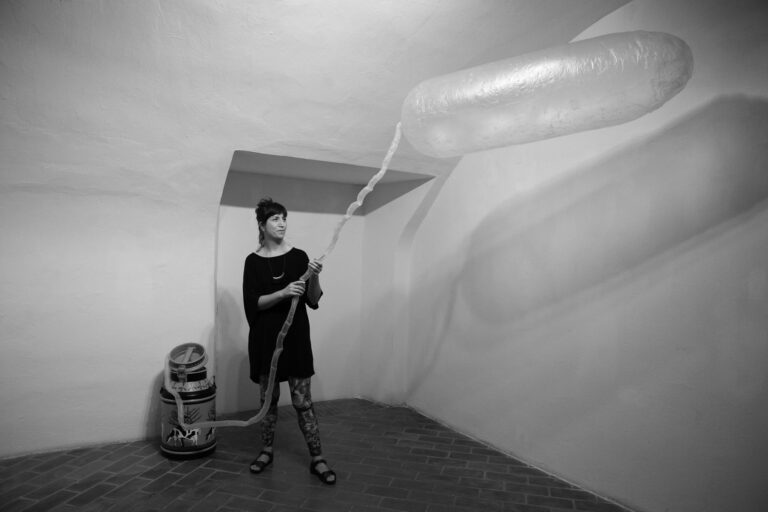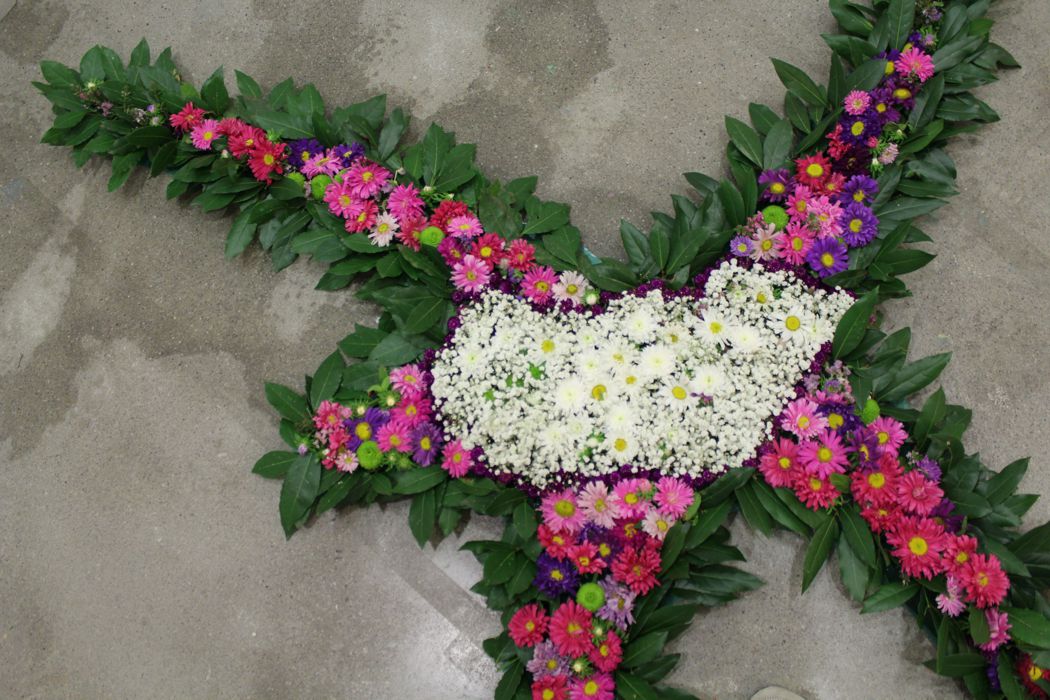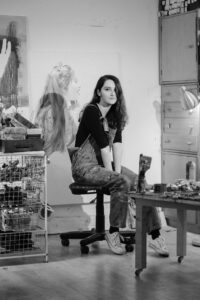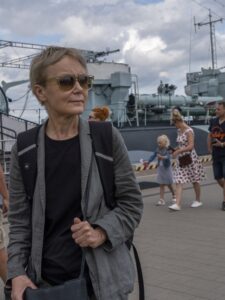Kitti Gosztola

– born in 1986, Székesfehérvár, graduated from Painting Department of the Hungarian University of Fine Arts, where she is currently pursuing her DLA studies. She primarily realizes research-based installation works that deal with the relationship between fine arts and environmental crises, as well as with politics of natural sciences. Her mediatically diverse practice ranges from experimenting with material features, through archival research, to socio-politically focused collaborations. Kitti Gosztola lives and works in Budapest.
The Gaja hypothesis
I am concerned with the connection between the sensual qualities and social meanings of art: I do not see the social and aesthetic aspects as a zero-sum relationship. My works dominantly deal with topics such as environmental crises and politics of natural sciences, as well as with their local and national aspects. My methods range from experimenting with material peculiarities, through archival research, to socio-politically focused collaborations: I make cultural-historical, artistic, mythological, philosophical knowledge collide, or bring them to a common denominator with natural, ecological, economic and political approaches.
I grew up in a small village where the anthropogenic “romance” of the landscape served as a basic experience. The window of my room had a view on a dolomite mine, and the water feeding the Gaja stream, a place for summer bathing came from the drained karst water of the neighbouring bauxite mine. I remember my long walks on the cattle pasture and the dairy woman who gave “pi water to them so they’ll give more milk. The local environment also inspired me to make a specific work. The series Right Tree Right Place was born from the peculiarity of trees truncated because of overhead power cables, and can also be interpreted as a grotesque version of the French garden celebrating domesticated nature.
My sensitivity towards the relationship between tradition and the unusual, between the planned and the natural environment stems from this childhood milieu too. Today, in my parents’ house, my father, my mother and her partner live together with the cats. Behind the newly inaugurated Turul monument, our neighbour’s passive house, is being dug into the ground; the smoke from its chimney penetrates my father’s lungs as he tries, with a rattle of plates, to call back Nyiu the tomcat who now prefers the neighbour’s food but loved playing with my father’s crutches beforehand. (I named him Solomon at birth because both females considered him their own kitten, but the name never stuck. Then my father attaches his prosthesis and drives off to the lake; he fishes with fish radar all night. He catches so much fish that he exchanges some of it during pig slaughter Cyborg and kinship at my country home.
As for feminism and socialism: the village museum was recently transformed into a bridal home for enacting a traditional wedding complete with folk music and costumes. Only the “I do” vows did not matter before God – as the local newspaper explained: “The lovers were wed by the pastor strictly following the rules, as if it were a real wedding.” But I am not part of this tradition of times past (and of times to come, perhaps). And I feel that the milieu of fine art is one of those (Hungarian) environments where there is no radical difference between the feminine and non-feminine experience – one that necessarily compels one to reflect on it -, although maybe the bridal home is already getting decorated here.
As a result of my studies, I focused my artistic interest on the re-reading of cultural history and concepts of civilizations from an ecological point of view12. Examples of this include Flashforward, which considers deforestation and the transmission of cultural patterns as the beginning of civilization from Giambattista Vico’s point of view, or the work entitled There is always room at the top, which combines the allusions of eco-ascetism and the stylites with geological strata in order to question the objective and subjective aspects of marking and naming the current geologic epoch.34
Of course, thoughts and material elements interconnect and shape each other. I like to bring forward and rearrange the qualities of a material, a tool or a natural or technological system that disappears in its habitual usage. In this respect, I often consult with craftsmen and researchers. The raw material of my work, Nulli Ultimus, is the membrane of the cow’s appendix, which the gas bags of dirigibles – or even whole airships – were once made of, but which can also be mentally and formally linked to the experimental balloons mounted on the backs of cattle in order to collect methane gas from their stomachs56. This material is also one of the basic material of parchment restoration, and I learned a lot from an expert during the preparation of the work, but I was also able to show her something new.
Finally, two collaborative projects represent a common form of thinking: in the prokaryote precariat trio that I formed together with Szilvi Német and Olivér Horváth, I deal with the imaginations surrounding (former Hungarian port town) Rijeka, the Hungarian sea and Hungarian marine research. In Wild Garden Utopia, together with Bence Pálinkás, and involving participants from outside the art world, I focus on the ethical-political ideals of the vegetal environment, especially through certain invasive plants, once considered valuable but now considered harmful78.
Recently, I have been studying the collection of the Pannonhalma Archabbey, the logic and structure of which differs from that of most art or historical archives. I also intensively deal with an anthropogenic and, may we say, invasive mineral called calclacite. Not only does this mineral spread with human intervention, but it is also created as a result of human activity, slowly covering rock samples, fossils and artefacts due to a chemical interaction with the wooden showcase that is supposed to preserve them. The archive wraps the work in its net910.
This statement was edited in collaboration with curator Fanni Magyar (2020).
1Image: Kitti Gosztola, Flashforward, 2019, krypton plasma, glass, plaster, plywood, heliogravure, variable dimensions, installation view, Kisterem Gallery, Budapest. Courtesy of the artist and Kisterem Gallery, Budapest.2Image: Kitti Gosztola, Flashforward – Zeus' Thunderbolt, 2019, krypton plasma, glass, 85 x 16 x 16 cm. Courtesy of the artist and Kisterem Gallery, Budapest.
3Image: Kitti Gosztola, There's always room at the top, 2020, expanded polystyrene (EPS), cement, wooden ladder 332 x 85 x 85 cm. Courtesy of the artist and Kisterem Gallery, Budapest.
4Image: Kitti Gosztola, There's always room at the top, 2020, detail. Courtesy of the artist and Kisterem Gallery, Budapest.
5Image: Kitti Gosztola, Cannula & Nulli Ultimus, 2018, painted aluminium milk can, goldbeater's skin (cow appendix), lifting gas, variable dimensions. Courtesy of the artist and Kisterem Gallery, Budapest.
6Images: Kitti Gosztola, Cannula & Nulli Ultimus, 2018, detail. Courtesy of the artist and Kisterem Gallery, Budapest.
7Image: Kitti Gosztola – Fanni Hegedűs – Bence György Pálinkás: Global Villager Instruments, 2017, collaborative project, video, handmade musical instruments (black locust, tree of heaven, Japanese knotweed), variable dimensions. Courtesy of the artist and Kisterem Gallery, Budapest.
8Image: Kitti Gosztola – Fanni Hegedűs – Bence György Pálinkás: Global Villager Instruments, 2017, collaborative project, video, handmade musical instruments (black locust, tree of heaven, Japanese knotweed), variable dimensions. Courtesy of the artist and Kisterem Gallery, Budapest.
9Image: Kitti Gosztola, prokaryote precariat: The Compass, 2017, flowers, floral foam, styrofoam, mortar, 300 x 40 x 300 cm. Courtesy of the artist and Kisterem Gallery, Budapest.
10Image: Kitti Gosztola, prokaryote precariat: The Compass, 2017, flowers, floral foam, styrofoam, mortar, 300 x 40 x 300 cm. Courtesy of the artist and Kisterem Gallery, Budapest.
– szül. 1986, Székesfehérvár, a Magyar Képzőművészeti Egyetem festő szakán végzett, ahol megkezdte DLA tanulmányit is. Elsősorban a képzőművészet és a környezeti válságok viszonyát, illetve a természettudományok politikumát tematizáló kutatás alapú installatív munkákat készít. Mediálisan változatos tevékenysége az anyagi sajátosságokkal való kísérletezéstől, az archívumi kutatásokon keresztül, a társadalmi-politikai fókuszú kollaborációkig ível. Gosztola Kitti Budapesten él és dolgozik.
Gaja-elmélet
A művészet érzéki minőségeinek és társadalmi jelentéseinek összekapcsolása foglalkoztat: a szociális és esztétikai vetületeket nem nulla összegű viszonynak látom. Munkáimban olyan témák dominálnak, mint a környezeti válságok és a természettudományok politikuma, valamint ezek lokális és nemzeti vetületei. Módszereim az anyagi sajátosságokkal való kísérletezéstől az archívumi kutatáson át a társadalmi-politikai fókuszú kollaborációkig ívelnek: kultúrtörténeti, művészeti, mitológiai, filozófiai tudásokat ütköztetek, vagy hozok közös nevezőre természeti, ökológiai, gazdasági vagy politikai megközelítésekkel.
Egy kis faluban nőttem fel, ahol a táj antropogén „romantikája” alapélményként szolgált. Gyerekszobám ablakából a kilátás egy dolomitbányára tárult, a nyári fürdőhelyként szolgáló Gaja-patakot a szomszédos bauxitbánya lecsapolt karsztvize táplálta. Emlékszem hosszas sétáimra a marhalegelőn, és a tejesasszonyra, aki a jobb hozam végett pi-vízzel itatta a teheneket. A helyi környezet egy konkrét művet is inspirált. Az elektromos vezetékek miatt megcsonkított fák különösségéből született a Jó fa, jó hely című sorozat, amely az idomított természetet ünneplő franciakert groteszk változatának is mondható.
A hagyomány és a szokatlan, valamint a tervezett és a természeti környezet közötti viszonyokra való kiélezettségem tehát ebből a gyerekkori miliőből is ered. A szülői házban ma édesapám, édesanyám és partnere hármasban él a macskákkal. A frissen avatott turul-emlékmű mögött a szomszédban, földbe ásott passzívház épül; kéményének füstje telibe csapja édesapámat, amint tányércsörgéssel csalogatja, a jobb falatokért a szomszédhoz átszokott Nyiu kandúrt, aki pedig korábban nagyon szeretett apám mankójával játszani. (Születésekor Salamonnak neveztem el, mert mindkét nőstény a kölykének tekintette, de ezt már egy ideje nem is teszem szóvá.) Aztán édesapám felcsatolja a protézisét, és elautózik a tóra; egész éjjel halradarral horgászik. Olyan sokat fog, hogy egy részét elcseréli disznóvágáskor. Kiborg és kinship hazalátogatásomkor.
Ami a feminizmust és a szocializmust illeti, nemrég a faluban a tájházat lányos házzá alakították, eljátszva egy népviseletes-táncos menyegzőt, amiben épp csak az Isten színe előtt kimondott „igen” nem számít: ahogy az újság írja: „A lelkipásztor pontosan betartva a szabályokat, úgy adta össze a szerelmeseket, mintha valódi esküvő lenne.” De én már/még nem ebben nőttem bele. És úgy érzem, a képzőművészeti közeg azon (magyar) közegek egyike ahol a női és nem-női tapasztalat között nincs radikális – elkerülhetetlen reflexióra késztető – eltérés, bár talán itt is díszítik már a lányos házat.
Tanulmányaim hatására, alkotói gyakorlatomban leginkább a kultúrtörténet, a civilizációképek ökológiai szempontú újraolvasása érdekel. Erre példa többek közt a Flashforward, amely Giambattista Vico nézetéből kiindulva gondolkodik a civilizáció kezdetét jelentő erdőirtásokról és a kulturális minták átörökítéséről12, vagy a A csúcson mindig van hely című mű, amely az öko-aszketizmus és az oszlopszentek allúzióit kombinálja földtörténeti oszlopok rétegjelöléseivel, rákérdezve a jelenkor jelölésének, elnevezésének objektív és szubjektív szempontjaira34.
A gondolati és a materiális elemek persze összefüggnek, formálják egymást. éSzeretem egy-egy anyag, eszköz vagy természeti, technológiai rendszernek a megszokott használatban eltűnő minőségeit előhozni, újrarendezni. Ennek kapcsán sokszor konzultálok mesteremberekkel és kutatókkal. Nulli Ultimus című munkám alapanyaga a szarvasmarha-vakbélhártya, ami régen a kormányozható léghajók gázcelláinak – vagy akár az egész léghajónak – a burkolatát adta, de gondolatilag és formailag is köthető a szarvasmarhák hátára szerelt, a gyomrukból kivezetett metángáz tárolására szolgáló ballonokhoz is56. Ez a hártya a pergamen restaurálás egyik alapanyaga is, így a mű elkészítése során sokat tanultam egy szakértőtől, de én is tudtam újat mutatni a számára.
Végül a gondolkodás közös formáját jelenti két kollaboratív projekt is: a prokaryote precariat trióban Német Szilvivel és Horváth Olivérrel közösen, Fiume és a magyar tenger, tengerkutatás képzeletvilágával foglalkozom, a Vad kert utópia keretében pedig, Pálinkás Bencével, a növényi környezet etikai-politikai ideáljaival, invazív – egykor értékesnek tartott, de ma kártékonynak ítélt – növények révén, az artworld-ön kívüli résztvevők bevonásával78.
Mostanában a Pannonhalmi Főapátság gyűjteményével foglalkozom, amelynek logikája és időszemlélete eltér a művészeti vagy történeti archívumokétól. Emellett Sokat gondolkozom a kalklacit nevű antropogén, és, talán mondhatni, invazív ásványon. Ez az ásvány nemcsak hogy emberi közreműködéssel terjed, hanem az emberi aktivitás következtében jön is létre, lassanként beborítva a kőzeteket, fosszílákat, műtárgyakat, amelyekre a megőrzésüket szolgáló tárlóból csapódik ki. Az archívum beszövi a művet.910
A statement Magyar Fanni kurátor közreműködésével jött létre (2020).
1Kép: Gosztola Kitti, Flashforward, kripton plazma, üveg, gipsz, rétegelt lemez, heliogravür, változó méretek, kiállítási nézet, Kisterem galéria, 2019. A művész és a Kisterem galéria jóvoltából.2Kép: Gosztola Kitti, Flashforward – Zeusz villáma, kripton plazma, üveg, 85 x 16 x 16 cm, 2019. A művész és a Kisterem galéria jóvoltából.
3Kép: Gosztola Kitti, A csúcson mindig van hely, 2020, habosított polisztirol (EPS), cement, falétra, 332 x 85 x 85 cm, 2020. A művész és a Kisterem galéria jóvoltából.
4Kép: Gosztola Kitti, A csúcson mindig van hely, 2020, részlet. A művész és a Kisterem galéria jóvoltából.
5Kép: Gosztola Kitti, Cannula & Nulli Ultimus, 2018, festett alumínium tejeskanna, aranyverő hártya (marhavakbél hártya), töltőgáz, változó méretek. A művész és a Kisterem galéria jóvoltából.
6Kép: Gosztola Kitti, Cannula & Nulli Ultimus, 2018, részlet. A művész és a Kisterem galéria jóvoltából.
7Kép: Gosztola Kitti – Hegedűs Fanni – Pálinkás Bence György: Világfalusi hangszerek, 2017, videó, kézzel készült hangszerek (fehér akác, mirigyes bálványfa, japán keserűfű), változó méret. A művész és a Kisterem galéria jóvoltából.
8Kép: Gosztola Kitti – Hegedűs Fanni – Pálinkás Bence György: Világfalusi hangszerek, 2017, videó, kézzel készült hangszerek (fehér akác, mirigyes bálványfa, japán keserűfű), változó méret. A művész és a Kisterem galéria jóvoltából.
9Kép: Gosztola Kitti, prokaryote precariat: Kompasz, 2017, vágott virág, tűzőhab, hungarocell, habarcs, 300 x 40 x 300 cm. A művész és a Kisterem galéria jóvoltából.
10Kép: Gosztola Kitti, prokaryote precariat: Kompasz, 2017, vágott virág, tűzőhab, hungarocell, habarcs, 300 x 40 x 300 cm. A művész és a Kisterem galéria jóvoltából.



